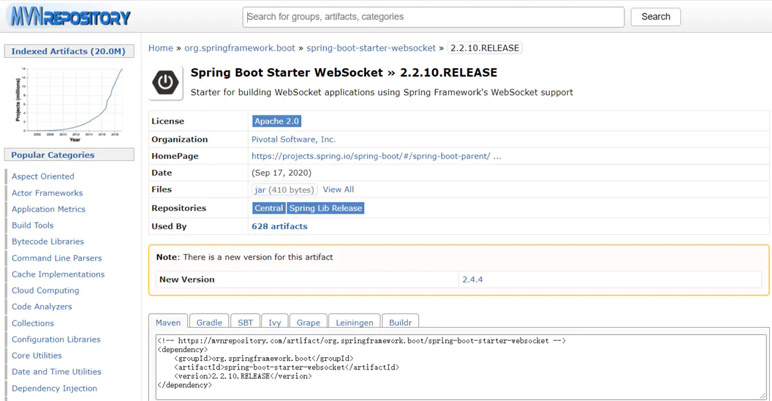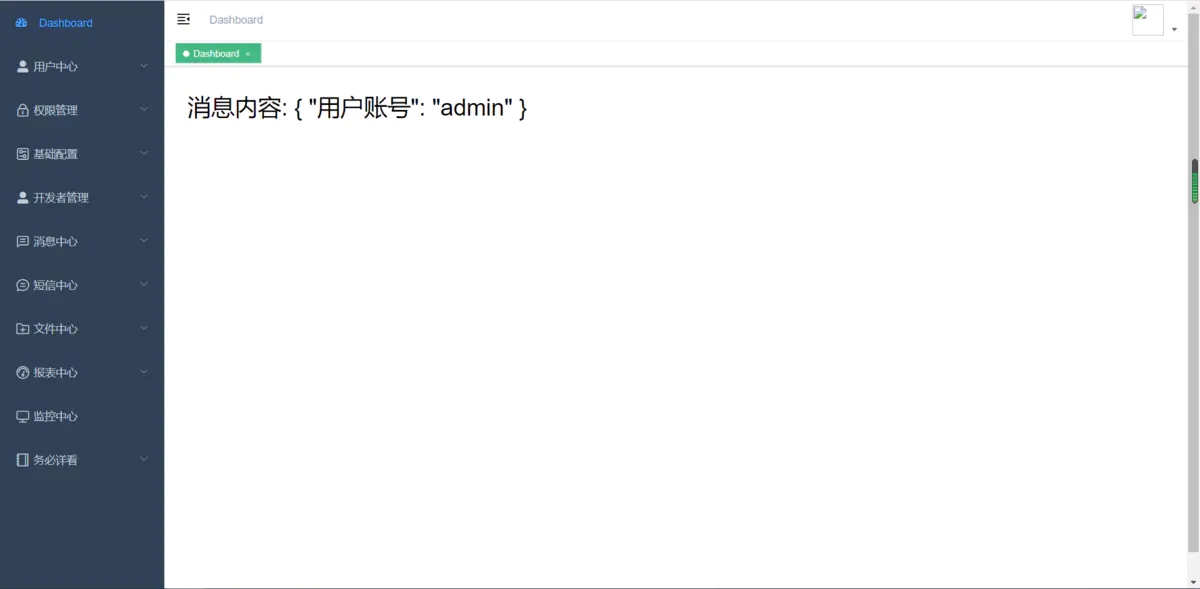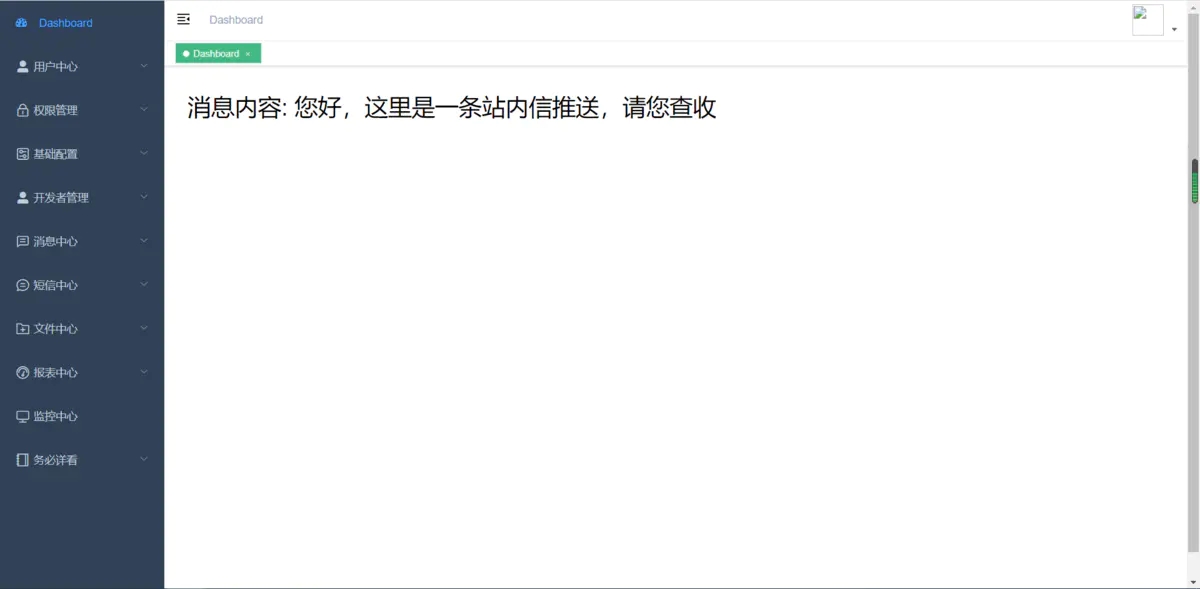下面我将和大家分享关于springboot框架结合websocket和redis项目搭建的内容,具体包括用Java实例代码展示搭建的具体过程。
一、原因
在某些业务场景,我们需要页面对于后台的操作进行实时的刷新,这时候就需要使用websocket。
通常在后台单机的情况下没有任何的问题,如果后台经过nginx等进行负载的话,则会导致前台不能准备的接收到后台给与的响应。socket属于长连接,其session只会保存在一台服务器上,其他负载及其不会持有这个session,此时,我们需要使用redis的发布订阅来实现,session的共享。
二、环境准备
在https://mvnrepository.com/里,查找websocket的依赖。使用springboot的starter依赖,注意对应自己springboot的版本。

<!-- https://mvnrepository.com/artifact/org.springframework.boot/spring-boot-starter-websocket -->
<dependency>
<groupId>org.springframework.boot</groupId>
<artifactId>spring-boot-starter-websocket</artifactId>
<version>2.2.10.RELEASE</version>
</dependency>除此之外添加redis的依赖,也使用starter版本:
<!-- redis -->
<dependency>
<groupId>org.springframework.boot</groupId>
<artifactId>spring-boot-starter-data-redis</artifactId>
</dependency>三、代码
redis监听配置:
/**
* @description: redis监听配置类
* @author:weirx
* @date:2021/3/22 14:08
* @version:3.0
*/
@Configuration
public class RedisConfig {
/**
* description: 手动注册Redis监听到IOC
*
* @param redisConnectionFactory
* @return: org.springframework.data.redis.listener.RedisMessageListenerContainer
* @author: weirx
* @time: 2021/3/22 14:11
*/
@Bean
public RedisMessageListenerContainer redisMessageListenerContainer(RedisConnectionFactory redisConnectionFactory) {
RedisMessageListenerContainer container = new RedisMessageListenerContainer();
container.setConnectionFactory(redisConnectionFactory);
return container;
}
}
webSocket配置:
/**
* @description: websocket配置类
* @author:weirx
* @date:2021/3/22 14:11
* @version:3.0
*/
@Configuration
public class WebSocketConfig {
/**
* description: 这个配置类的作用是要注入ServerEndpointExporter,
* 这个bean会自动注册使用了@ServerEndpoint注解声明的Websocket endpoint。
* 如果是使用独立的servlet容器,而不是直接使用springboot的内置容器,
* 就不要注入ServerEndpointExporter,因为它将由容器自己提供和管理。
*
* @return: org.springframework.web.socket.server.standard.ServerEndpointExporter
* @author: weirx
* @time: 2021/3/22 14:12
*/
@Bean
public ServerEndpointExporter serverEndpointExporter(){
return new ServerEndpointExporter();
}
}
redis工具类:
@Component
public class RedisUtil {
@Autowired
private StringRedisTemplate stringRedisTemplate;
/**
* 发布
*
* @param key
*/
public void publish(String key, String value) {
stringRedisTemplate.convertAndSend(key, value);
}
}
WebSocket服务提供类:
/**
* description: @ServerEndpoint 注解是一个类层次的注解,
* 它的功能主要是将目前的类定义成一个websocket服务器端,注解的值将被用于监听用户连接的终端访问URL地址,
* 客户端可以通过这个URL来连接到WebSocket服务器端使用springboot的唯一区别是要@Component声明下,
* 而使用独立容器是由容器自己管理websocket的,但在springboot中连容器都是spring管理的。
*
* @author: weirx
* @time: 2021/3/22 14:31
*/
@Slf4j
@Component
@ServerEndpoint("/websocket/server/{loginName}")
public class WebSocketServer {
/**
* 因为@ServerEndpoint不支持注入,所以使用SpringUtils获取IOC实例
*/
private RedisMessageListenerContainer redisMessageListenerContainer =
ApplicationContextProvider.getBean(RedisMessageListenerContainer.class);
/**
* 静态变量,用来记录当前在线连接数。应该把它设计成线程安全的。
*/
private static AtomicInteger onlineCount = new AtomicInteger(0);
/**
* concurrent包的线程安全Set,用来存放每个客户端对应的webSocket对象。
* 若要实现服务端与单一客户端通信的话,可以使用Map来存放,其中Key可以为用户标识
*/
private static CopyOnWriteArraySet<WebSocketServer> webSocketSet = new CopyOnWriteArraySet<WebSocketServer>();
/**
* 与某个客户端的连接会话,需要通过它来给客户端发送数据
*/
private Session session;
/**
* redis监听
*/
private SubscribeListener subscribeListener;
/**
* 连接建立成功调用的方法
*
* @param session 可选的参数。session为与某个客户端的连接会话,需要通过它来给客户端发送数据
*/
@OnOpen
public void onOpen(@PathParam("loginName") String loginName, Session session) {
this.session = session;
//加入set中
webSocketSet.add(this);
//在线数加1
addOnlineCount();
log.info("有新连接[" + loginName + "]加入!当前在线人数为{}", getOnlineCount());
subscribeListener = new SubscribeListener();
subscribeListener.setSession(session);
//设置订阅topic
redisMessageListenerContainer.addMessageListener(
subscribeListener, new ChannelTopic(Constants.TOPIC_PREFIX + loginName));
}
/**
* 连接关闭调用的方法
*/
@OnClose
public void onClose() throws IOException {
//从set中删除
webSocketSet.remove(this);
//在线数减1
subOnlineCount();
redisMessageListenerContainer.removeMessageListener(subscribeListener);
log.info("有一连接关闭!当前在线人数为{}", getOnlineCount());
}
/**
* 收到客户端消息后调用的方法
*
* @param message 客户端发送过来的消息
* @param session 可选的参数
*/
@OnMessage
public void onMessage(String message, Session session) {
log.info("来自客户端的消息:{}", message);
//群发消息
for (WebSocketServer item : webSocketSet) {
try {
item.sendMessage(message);
} catch (IOException e) {
log.info("发送消息异常:msg = {}", e);
continue;
}
}
}
/**
* 发生错误时调用
*
* @param session
* @param error
*/
@OnError
public void onError(Session session, Throwable error) {
log.info("发生错误,{}", error);
}
/**
* 这个方法与上面几个方法不一样。没有用注解,是根据自己需要添加的方法。
*
* @param message
* @throws IOException
*/
public void sendMessage(String message) throws IOException {
this.session.getBasicRemote().sendText(message);
}
public int getOnlineCount() {
return onlineCount.get();
}
public void addOnlineCount() {
WebSocketServer.onlineCount.getAndIncrement();
}
public void subOnlineCount() {
WebSocketServer.onlineCount.getAndDecrement();
}
}
redis消息发布:
@Autowired
private RedisUtil redisUtil;
@Override
public Result send(String loginName, String msg) {
//推送站内信webSocket
redisUtil.publish("TOPIC" + loginName, msg);
return Result.success();
}
前端vue代码:
<template>
<div class="dashboard-container">
<div class="dashboard-text">消息内容: {{ responseData }}</div>
</div>
</template>
<script>
import {mapGetters} from 'vuex'
export default {
data() {
return {
websocket: null,
responseData: null
}
},
created() {
this.initWebSocket();
},
destroyed() {
this.websock.close() //离开路由之后断开websocket连接
},
methods: {
//初始化websocket
initWebSocket() {
const wsUri = "ws://127.0.0.1:21116/websocket/server/" + "admin";
this.websock = new WebSocket(wsUri);
this.websock.onmessage = this.websocketonmessage;
this.websock.onopen = this.websocketonopen;
this.websock.onerror = this.websocketonerror;
this.websock.onclose = this.websocketclose;
},
websocketonopen() { //连接建立之后执行send方法发送数据
let actions = {"用户账号": "admin"};
this.websocketsend(JSON.stringify(actions));
},
websocketonerror() {//连接建立失败重连
this.initWebSocket();
},
websocketonmessage(e) { //数据接收
const redata = JSON.parse(e.data);
this.responseData = redata;
},
websocketsend(Data) {//数据发送
this.websock.send(Data);
},
websocketclose(e) { //关闭
console.log('断开连接', e);
},
},
name: 'Dashboard',
computed: {
...mapGetters([
'name',
'roles'
])
}
}
</script>四、测试

发送前

发送后
到此这篇关于 springboot、websocket和redis搭建的详细过程的文章就介绍到这了,更多相关springboot,websocket以及redis其他方面的内容请搜索W3Cschool以前的文章或继续浏览下面的相关文章希望大家以后多多支持我们!


